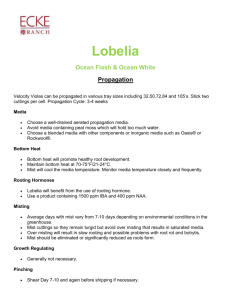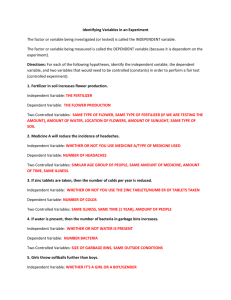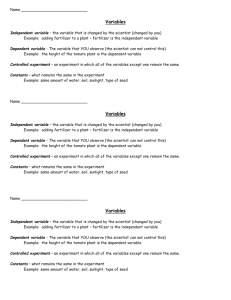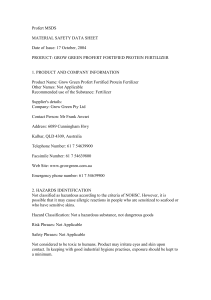Fertilizing ferns - Soil and Water Science
advertisement
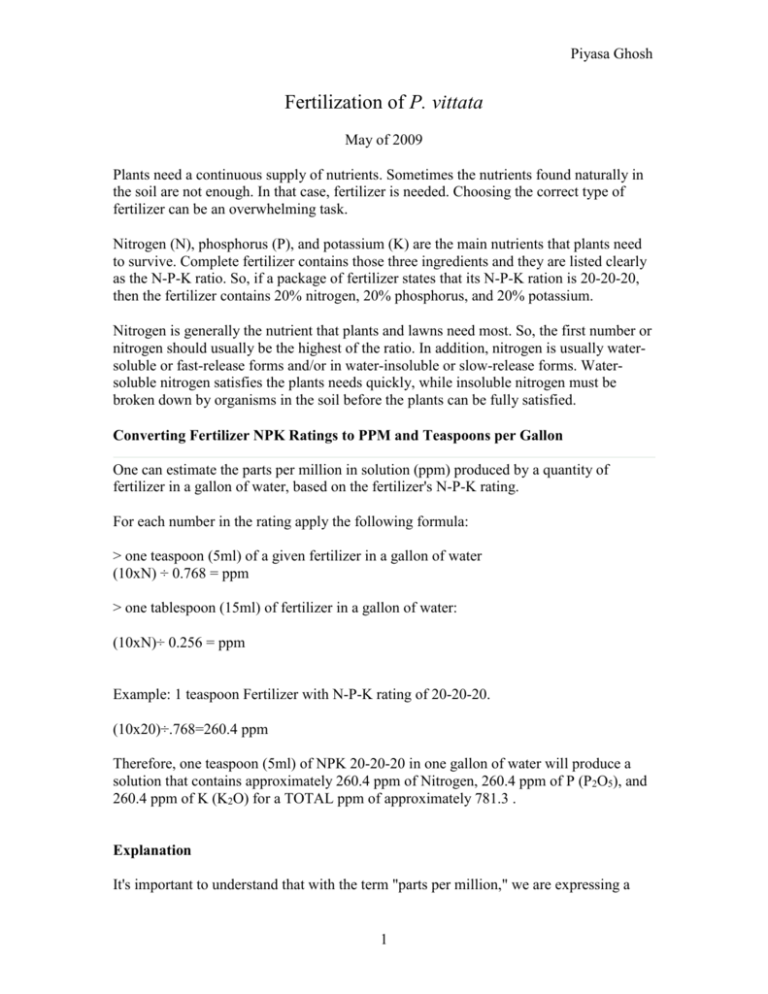
Piyasa Ghosh Fertilization of P. vittata May of 2009 Plants need a continuous supply of nutrients. Sometimes the nutrients found naturally in the soil are not enough. In that case, fertilizer is needed. Choosing the correct type of fertilizer can be an overwhelming task. Nitrogen (N), phosphorus (P), and potassium (K) are the main nutrients that plants need to survive. Complete fertilizer contains those three ingredients and they are listed clearly as the N-P-K ratio. So, if a package of fertilizer states that its N-P-K ration is 20-20-20, then the fertilizer contains 20% nitrogen, 20% phosphorus, and 20% potassium. Nitrogen is generally the nutrient that plants and lawns need most. So, the first number or nitrogen should usually be the highest of the ratio. In addition, nitrogen is usually watersoluble or fast-release forms and/or in water-insoluble or slow-release forms. Watersoluble nitrogen satisfies the plants needs quickly, while insoluble nitrogen must be broken down by organisms in the soil before the plants can be fully satisfied. Converting Fertilizer NPK Ratings to PPM and Teaspoons per Gallon One can estimate the parts per million in solution (ppm) produced by a quantity of fertilizer in a gallon of water, based on the fertilizer's N-P-K rating. For each number in the rating apply the following formula: > one teaspoon (5ml) of a given fertilizer in a gallon of water (10xN) ÷ 0.768 = ppm > one tablespoon (15ml) of fertilizer in a gallon of water: (10xN)÷ 0.256 = ppm Example: 1 teaspoon Fertilizer with N-P-K rating of 20-20-20. (10x20)÷.768=260.4 ppm Therefore, one teaspoon (5ml) of NPK 20-20-20 in one gallon of water will produce a solution that contains approximately 260.4 ppm of Nitrogen, 260.4 ppm of P (P2O5), and 260.4 ppm of K (K2O) for a TOTAL ppm of approximately 781.3 . Explanation It's important to understand that with the term "parts per million," we are expressing a 1 Piyasa Ghosh measurement in terms of a RATIO, which, like miles per hour or pounds per square inch, is a relation in degree or number between two separate measurements. "Parts per million" is a common way of expressing the measurement of the dilution of something in solution, which for our purposes here, is the dilution of fertilizer components in water. It just so happens that fertilizer N-P-K ratings are also ratios, as is the measurement of teaspoons per gallon. Parts per million is most often alternately expressed as milligrams per liter because it's so easy to convert due to the efficiency of the metric system: 1000 milligrams = 1 gram and 1000 grams of water = 1 liter; 1 thousand x 1 thousand = 1 million; voilá- parts per million. Fortunately, the "parts" in "parts per million" are generic. It can be parts of a teaspoon just as easily as it can be parts of a gram. N-P-K ratios are also generic expressions of percentage, or parts per hundred. Water soluble fertilizer NPK 20-20-20 Procedure for fertilizing P. vittata by NPK 20-20-20 in Fafard germinating mix II 1. 2. 3. 4. Prepare a solution of the fertilizer dissolving 500 mg in 1 l of water (500 ppm). Segregation of similar pots with similar size of P. vittata plants. The plants should not be watered 6 hours before and after fertilizing. One pot of each pot size should be isolated and used for estimating the amount of fertilizer that should be added to each pot: 2 Piyasa Ghosh a) Preliminary add 50 ml of fertilizer solution to each pot and estimate the max holding capacity of each pot in such a way so that the fertilizer does not seep out from the bottom of the pot. (This basically depends on the root volume and the water holding capacity of the soil). b) Then approximately add specific volume of fertilizer solution to similar pots with similar plants estimated by the above procedure. 5. Dose of application for plants which may be used for experiment to maintain uniform size: once every 15 days. Comment: The concentration of fertilizer that will be added by this procedure is dilute and will cause no harmful effects that are usually observed due to excess addition of fertilizers to P. vittata grown in Fafard mix II. However the fertilizer type and dose of application may change with the change in soil conditions. Acknowledgement: Special thanks to Dr. Saba for lending the method of fertilizing ferns used in his greenhouse. 3

